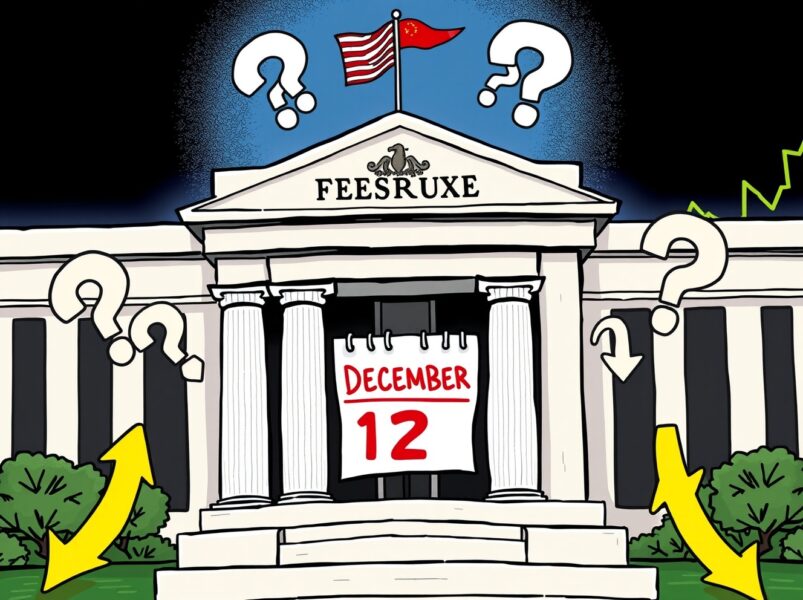December Fed Rate Cut Odds Plummet: What This Means for Your Investments
0
0

BitcoinWorld

December Fed Rate Cut Odds Plummet: What This Means for Your Investments
Market expectations for a December Fed rate cut are rapidly fading, creating significant implications for investors and traders. The sudden shift in sentiment follows the unexpected cancellation of October’s crucial jobs report, leaving economists and market participants in the dark about key employment data that typically guides Federal Reserve decisions.
Why Are December Fed Rate Cut Odds Declining?
The probability of a December Fed rate cut has dropped substantially after the U.S. Bureau of Labor Statistics announced it will not release its October employment report. This critical data point serves as a cornerstone for Federal Reserve policy decisions, and its absence creates substantial uncertainty in monetary policy forecasting.
Without the October jobs report, Federal Reserve officials lack essential information about:
- Employment growth trends
- Wage inflation pressures
- Labor market participation rates
- Unemployment dynamics
How Does Missing Data Impact Fed Decisions?
The Federal Reserve relies heavily on consistent economic data to make informed decisions about interest rates. When key reports like the jobs data disappear from the landscape, policymakers become more cautious about implementing significant changes to monetary policy.
This data gap means the December Fed rate cut becomes less likely because officials prefer to act with comprehensive information. The absence of October employment figures creates a blind spot in understanding whether the labor market continues to cool or remains robust.
What Are the Market Implications?
The declining odds of a December Fed rate cut have immediate consequences across financial markets. Bond yields may rise as traders adjust their expectations, while equity markets could face pressure from higher borrowing costs.
Key sectors that benefit from lower interest rates—such as real estate and technology—may experience increased volatility. Meanwhile, the U.S. dollar could strengthen as delayed rate cuts maintain higher yield differentials compared to other currencies.
What Should Investors Watch Now?
With the December Fed rate cut probability shrinking, investors should monitor alternative economic indicators that might influence Federal Reserve thinking. These include:
- CPI inflation data – The next consumer price index report
- Retail sales figures – Consumer spending patterns
- Manufacturing surveys – PMI and industrial production
- Federal Reserve speeches – Public comments from officials
Conclusion: Navigating the Uncertainty
The reduced likelihood of a December Fed rate cut underscores how dependent markets are on consistent economic data. While the missing jobs report creates short-term uncertainty, it also highlights the importance of diversified investment strategies that can withstand unexpected data disruptions.
As we approach the final Federal Reserve meeting of the year, market participants should prepare for potential volatility and maintain flexibility in their positioning. The December Fed rate cut story demonstrates that in today’s complex economic environment, being prepared for data surprises is just as important as reacting to expected outcomes.
Frequently Asked Questions
Why was the October jobs report cancelled?
The U.S. Bureau of Labor Statistics cited technical issues and data collection challenges as the primary reasons for cancelling the October employment report release.
How does this affect the likelihood of a December Fed rate cut?
The missing data makes a December Fed rate cut less probable because policymakers prefer comprehensive information before making significant monetary policy changes.
What other economic indicators will the Fed consider now?
The Federal Reserve will likely place greater emphasis on inflation data, retail sales, manufacturing surveys, and other labor market indicators to compensate for the missing jobs report.
How long will the data gap affect Fed decisions?
The impact should be temporary, as November data will eventually fill some gaps, but the missing October data creates a permanent hole in the economic timeline.
Should investors change their strategies because of this?
While investors should monitor the situation, drastic strategy changes based on single data points (or missing data) are generally not recommended.
When will we get clarity on Fed rate decisions?
Clearer signals should emerge after the November jobs report and additional economic data releases in coming weeks.
Found this analysis helpful? Share this article with fellow investors on social media to help them understand the changing December Fed rate cut landscape and make informed decisions in these uncertain market conditions.
To learn more about the latest Federal Reserve policy trends, explore our article on key developments shaping interest rate decisions and future monetary policy direction.
This post December Fed Rate Cut Odds Plummet: What This Means for Your Investments first appeared on BitcoinWorld.
0
0
 Manage all your crypto, NFT and DeFi from one place
Manage all your crypto, NFT and DeFi from one placeSecurely connect the portfolio you’re using to start.




